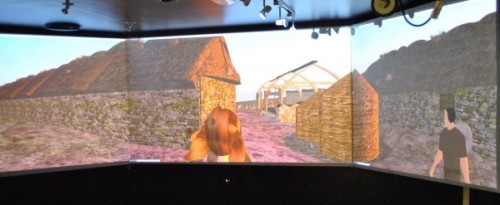The Oculus Rift Kickstarter Campaign is a virtual reality head-mounted display for computer gamers that was funded in 2012, since then development has continued on the project with a number of technical improvements.
The Oculus Rift Development Kit 2 (DK2) was released on March 19, 2014 and is the latest version available for developers, it includes a low-persistence OLED (organic light-emitting diode) display which eliminates motion blur and judder, high-definition display and precise low-latency positional head tracking using an external camera allowing the user to move with 6-degrees-of-freedom allowing looking around corners and leaning forward to take a closer look at objects.
On March 25th, 2014 the Oculus VR company was purchased by Facebook for $2bn to enable them to focus on the next evolution in social communications. They are also interested in the potential of experiencing sports events from a seat in the stadium, studying with students and teachers from all over the world in a virtual classroom environment and consultation face-to-face with a doctor virtually.
The Oculus Rift Development Kit 2 can be ordered from the website for $350, but the consumer version is not going to be released until 2015.
Potential
The Oculus Rift has great potential for the immersive viewing of digital media of both archaeological excavations and cultural heritage, whether stitched together photographs from systems such as the Panono or video from such systems as the 360cam, but it is also capable of immersive experiences of 3D recreations of sites. Photogrammetry or other recording techniques can be used to record areas under study and all of these technologies can be used to view material as part of the excavation decision strategy or for experts in different locations to view and comment.
It could be used as part of the post-excavation process where those writing up the project could review areas of the excavation to aid in their understanding of the archaeology.
Virtual reality has previously been used in museum and visitor centre applications, but with increased computing hardware and software power more realistic renditions can be created together with the immersive experience provided by the Oculus Rift. The system is designed to work with the Unreal Development Kit, Unreal Engine 4, and Unity 4 game engine technology allowing easy integration between 3D representations created in this software and the Oculus Rift. Here is a demonstration of the Oculus Rifts integration with Unreal Engine 3.
There have been many previous attempts at immersive archaeology including the French Immersia, an open immersive infrastructure, where the representation is projected onto four glass screens by combining the images from 13 HD projectors. 16 infrared cameras are used for a tracking system which can track people as they move around within the scene, recomputing the view that is seen as the person moves around the scene.

While the University of St Andrews has created a Virtual Museum where people can visit a museum which virtually displays the Caen Township in 1813 on the wall, interaction with the system can be made via a Microsoft Kinect. The reconstruction is also available online and via a downloadable application.

The Duke immersive Virtual Environment project (DiVE) allows the creation of 1:1 scale immersive representations of sites including an immersive tour of the site of Çatalhöyük. The DiVE system is a six-sided room with stereoscopic rear projection on all of the surfaces, the visuals are viewed with stereo glasses which provide depth perception while a “wand” held in the hand allows navigation and interaction with virtual objects.

The system at the DiVE has the additional abilities of showing “in-context stratigraphic layers menu, volumetric visualization of the excavated areas, shaders, first-hand interaction with the models, and a virtual anastylosis that shows how the building looked like before being abandoned”.

The Oculus Rift removes the need for these expensive rooms systems, providing more immersive visuals with the use of a head-mounted display. Although the current version requires external power and direct connection to a computer, hopefully future version will be battery powered and wireless allowing a more free experience.
Limitations
The Oculus Rift is an added expense to a project, but not a great expense and can be used again on other projects.
As it is designed to be worn it is limited to one person at a time, so if multiple people needed to use it at once multiple displays would be needed.
The Oculus Rift uses the HDMI output from the computer that is generating the visuals, so unless the graphics card has two HDMI outputs the cable would need to be swapped over constantly.
A number of cheap or free mounts for smartphones, where the phone acts as the 3D projector, have recently been released, and although their abilities are currently limited they may to be the future of virtual reality visualisation in archaeology and cultural heritage.






